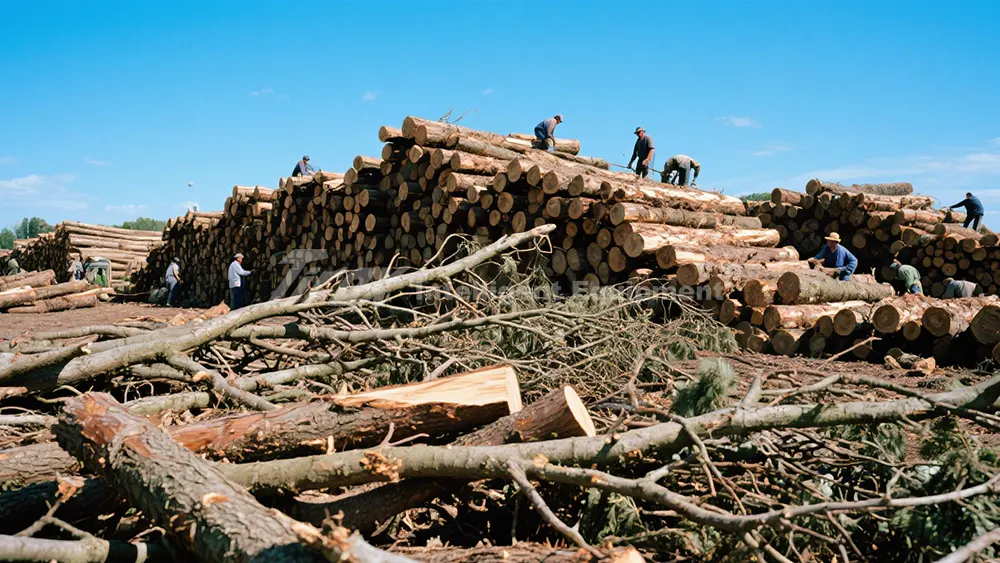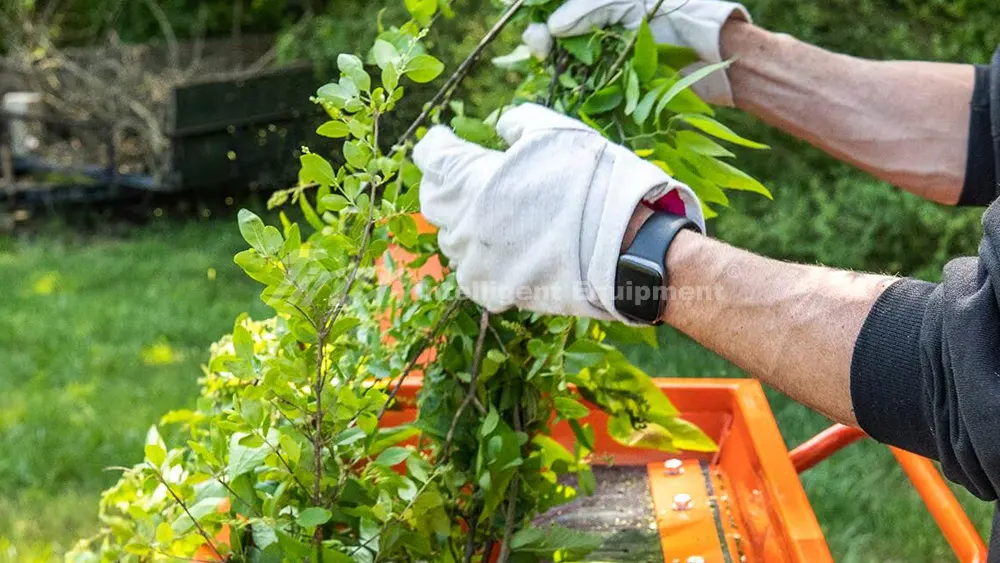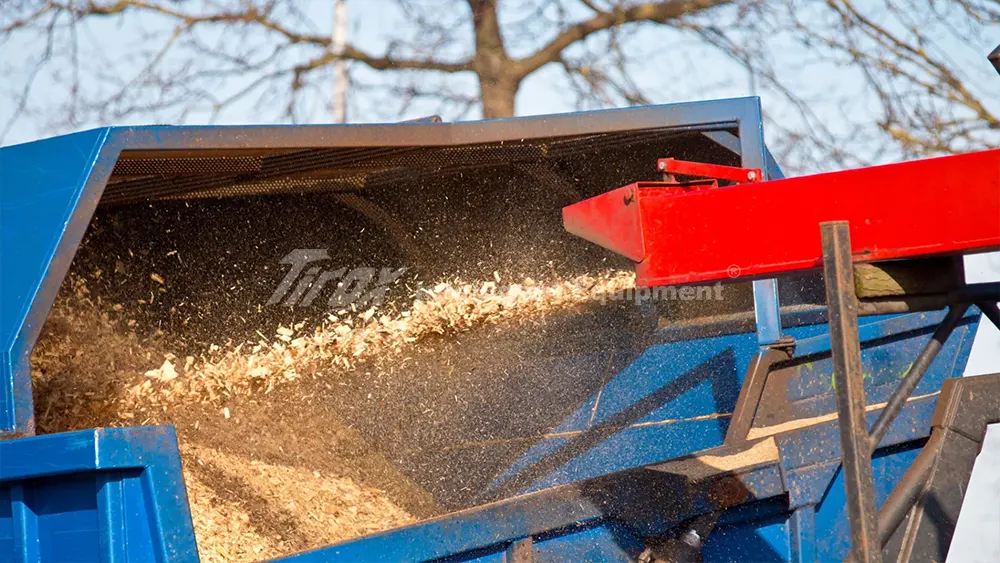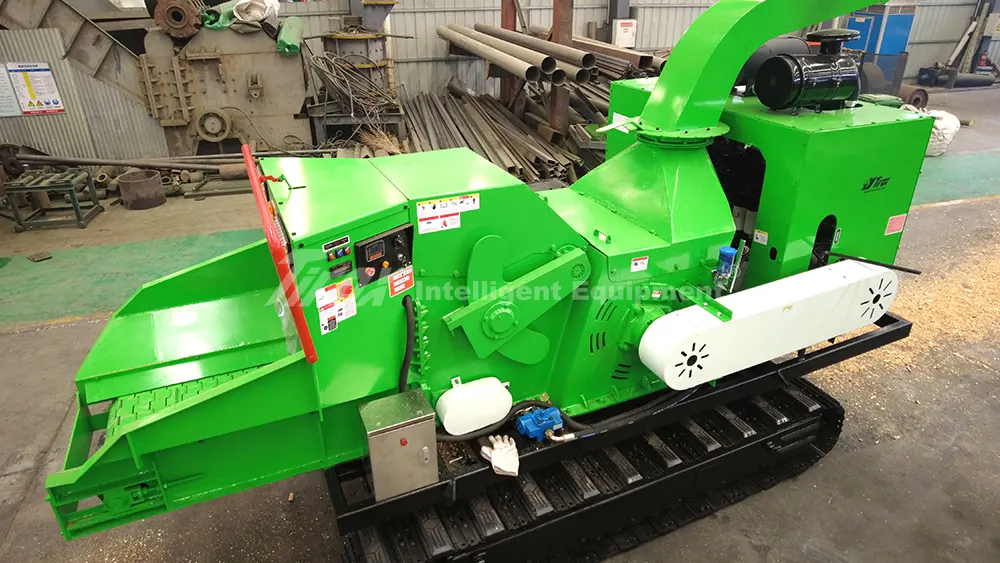Your yard is full of fallen leaves. Your wood chipper sits nearby. Can it easily turn those leaves into mulch, or will you cause a messy problem for your machine?
Generally, you can feed small amounts of leaves into a wood chipper, especially if mixed with branches. But, feeding large piles of loose, wet leaves alone is often a bad idea. This can clog the chipper and make it work much less effectively.
As a manufacturer here at TIROX with 22 years in the industry, I’ve seen many people try to use their wood chippers for all sorts of garden waste. While our machines are built strong – “Made in China + International Quality” is what we aim for – it is important to understand what they do best. This helps them last longer and perform well. Let’s look into this a bit more.
What not to put in a wood chipper?
You have a big pile of waste material to clear. Your wood chipper looks like the perfect tool. But are there things that should absolutely never go into it? Putting the wrong items in can lead to serious damage, or even be dangerous.
You should never put metal, rocks, glass, hard plastics, rubber, very wet or muddy materials, large tree stumps with extensive root systems, or long, stringy items like ropes and vines into a wood chipper. These things can break blades, clog the machine, or become dangerous projectiles.

I clearly remember a situation where one of our customers, a construction and demolition company [B2B Target Customer: Construction & Demolition Companies], was trying to process some mixed site debris. They did not see a piece of metal rebar mixed in. The moment it hit the chipper blades, it caused severe damage to both the blades and the main cutting drum. Even with robust machines like ours, designed for “Technological Leadership,” metal is a complete no-go. Rocks and dirt are also very problematic. They are abrasive, meaning they act like sandpaper on the blades, making them dull very quickly. A larger stone can chip or even break a blade instantly. Glass and hard plastics might seem easy to break, but they do not chip like wood. They can shatter into sharp, dangerous fragments inside the machine or be thrown out. Softer plastics and rubber, like old garden hoses, can wrap around the rotor or shafts. This creates big clogs that can damage the engine or hydraulic system. Very wet material, like soggy leaves or mud-caked branches, can turn into a paste inside the chipper. This blocks the discharge chute and makes cleaning very difficult. Large tree stumps with a lot of roots are generally too big and tough for standard chippers. Our specialized Horizontal Grinders might handle some, but regular chippers will struggle. Finally, items like long vines, ropes, or even pieces of fabric can get tangled around the rotor and feed rollers. This jams the machine very fast and can stop it from working. Knowing these limits is very important for safety and for keeping your TIROX chipper working well for a long time.
Items That Should Never Go Into Your Wood Chipper
| Item | Why It Is Bad for Your Chipper | Potential Damage or Hazard |
|---|---|---|
| Metal Objects | Extremely hard, does not break down like wood. | Instantly breaks or chips blades, damages rotor, creates spark risk. |
| Rocks, Stones, Sand, Dirt | Highly abrasive, can be very hard. | Quickly dulls blades, can chip or break blades. |
| Glass | Shatters into sharp, unpredictable pieces. | Damages blades, creates dangerous flying debris, contaminates chips. |
| Hard Plastics & Rubber | Does not chip properly, can melt or wrap around moving parts. | Clogs machine, damages internal parts, potential fire risk if melted. |
| Very Wet or Muddy Waste | Can form a thick, sticky paste inside the machine. | Clogs feed system and discharge chute, reduces efficiency, hard to clean. |
| Large Stumps with Roots | Often too large, dense, and irregularly shaped for standard chippers. | Overstrains engine, can jam or damage rotor and feed mechanism. |
| Long Vines, Ropes, Fabric | Can wrap tightly around rotating shafts and feed rollers. | Causes severe clogs, stops machine operation, can damage bearings. |
Avoiding these materials is key to protecting your equipment and ensuring safe operation, helping you get the most from your TIROX investment.
What is the difference between a leaf mulcher and a wood chipper?
You have heard about leaf mulchers and wood chippers, and they sound like they do similar jobs. But they are designed for very different tasks. Knowing this difference helps you choose the right tool and avoid damaging your equipment.
A leaf mulcher is specifically designed to shred soft, leafy garden waste, like fallen leaves and small twigs, into fine mulch. A wood chipper, however, is a more powerful machine built to process harder, larger pieces of wood, such as tree branches and small logs, into wood chips.

At TIROX, our main focus is on wood chippers and heavy-duty wood recycling equipment like Horizontal Grinders. This is because our core B2B customers, such as Forestry & Logging Companies or Biomass Energy Companies, need to process substantial volumes of solid wood. The main difference lies in their internal mechanisms and their power. A leaf mulcher typically uses a set of hammer flails or small, often string-based, cutting lines. These are designed to tear and shred soft, pliable materials. The power output of a leaf mulcher is usually much lower, and its feed opening is smaller, suited for loose leaves and thin, green twigs. The end product is a fine, often fluffy mulch, which is great for composting or as a top dressing for garden beds. A wood chipper, particularly the kind we manufacture, uses heavy-duty, very sharp steel knives or blades. These are mounted on a heavy, rapidly rotating disc or drum. These blades slice through solid wood with considerable force. The engine on a wood chipper is much more powerful, often a diesel engine for our larger models, to handle the demands of tough, dense wood. The feed opening is also significantly larger to accommodate thicker branches or even small logs. The output from a chipper is typically larger, more uniform wood chips. These chips are valuable for things like biomass fuel, landscaping mulch, animal bedding, or even as raw material for pressed wood products. For a customer like a Large Farm or a Landscaping Company, understanding which machine is suited for their specific type of waste is very important. Our TIROX wood chippers are engineered for the tough job of wood reduction, reflecting our “Technological Leadership” in this area.
Key Differences: Leaf Mulcher vs. Wood Chipper
| Feature | Wood Chipper | Leaf Mulcher |
|---|---|---|
| Primary Function | To cut and break down solid wood branches and logs into chips. | To shred soft, leafy materials and small green twigs into fine mulch. |
| Cutting Mechanism | Heavy, sharp steel knives/blades on a rotating disc or drum that slice. | Hammer flails, cutting lines, or small tearing blades that shred. |
| Power Source & Level | Higher power; often gasoline or diesel engines for larger units. | Lower power; often electric or small gasoline engines. |
| Material Capacity | Handles hard wood, branches up to several inches in diameter. | Best for leaves, grass clippings, soft plant stalks, thin twigs. |
| Feed Opening Size | Larger, to accommodate thicker branches. | Smaller, designed for loose, less bulky materials. |
| Output Product | Wood chips (coarser, more uniform in size). | Fine mulch or shredded material (fluffier, less uniform). |
| Typical Use Case | Clearing storm damage, tree pruning, biomass production, land clearing. | Garden cleanup, composting, creating decorative mulch for flower beds. |
Choosing the correct machine for your specific waste type ensures you get the job done efficiently and without damaging your equipment.
Can you put dried branches in a wood chipper?
You have a pile of branches that have been drying out for a while, perhaps from last season’s pruning. They are hard and seem brittle. Can your wood chipper handle them effectively, or is there anything you should be cautious about?
Yes, you can definitely put dried branches into a wood chipper. In many cases, dry wood processes more efficiently and can produce cleaner, more uniform chips compared to green, freshly cut wood. However, be aware that very old or extremely brittle wood might splinter more, and always check for embedded debris.
I often discuss this with our customers, including those in forestry and logging [B2B Target Customer: Forestry & Logging Companies] who use our equipment like the Tracked Horizontal Grinders. These machines are designed to handle large volumes of wood, often dry, directly in challenging forest environments. When wood is green, it contains a high percentage of moisture. This moisture can sometimes make the chipping process a bit more challenging for the blades, and the resulting chips might be stringier or wetter. Dry wood, on the other hand, has lost much of this internal moisture, making it less dense. This generally allows the chipper blades to cut through it more cleanly and with less resistance. The result is often crisper, more uniform chips. This can also put less strain on the chipper’s engine, potentially leading to better fuel efficiency and smoother operation. However, there are a couple of points to keep in mind. Wood that is extremely old or exceptionally brittle can sometimes shatter or splinter in a less predictable way when it hits the blades. This might lead to a bit more dust being produced during the chipping process. It could also mean that some of the resulting chips are less uniform in size than you might expect. Also, a very important point: if the wood has been lying on the ground for an extended period, it’s more likely to have picked up dirt, sand, or small stones. As I mentioned earlier, any kind of foreign, abrasive material is detrimental to the life of your chipper blades. So, it is always a good habit to inspect dried branches for any embedded debris before feeding them into the chipper. In general, though, dry wood is often preferable for chipping, leading to a smoother operation for your machine and a higher quality end product. This kind of practical advice is part of the “Worry-Free Global After-Sales” support we aim to provide, ensuring our customers get the best performance from their TIROX equipment.
Chipping Dried Branches: Advantages and Considerations
| Aspect | Advantages of Chipping Dried Wood | Potential Considerations or Challenges |
|---|---|---|
| Chipping Efficiency | Often easier for blades to cut through, potentially less engine strain. | Very hard, old dry wood might still require significant power. |
| Quality of Chips | Produces cleaner, drier, more uniform chips; good for biomass/mulch. | Extremely brittle wood can shatter, creating more fine dust and splinters. |
| Blade Wear | Less moisture means less “gummy” residue on blades. | Increased risk if dry wood has embedded dirt, sand, or stones. |
| Machine Operation | Can lead to smoother operation and potentially lower fuel use. | Higher dust output might require more frequent air filter checks/cleaning. |
| Moisture Content | Low moisture content is ideal for immediate use as fuel or dry mulch. | N/A – this is generally an advantage. |
Overall, dried branches are perfectly suitable for chipping, but a quick inspection for contaminants is always a smart step.
Conclusion
Yes, you can chip some leaves mixed with branches. But avoid large wet leaf piles. Never chip metal or rocks. Remember, chippers handle wood; mulchers handle soft waste. Dry branches usually chip very well.






